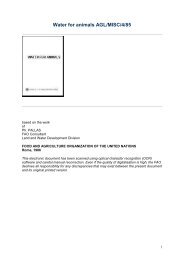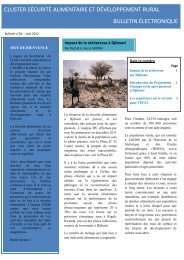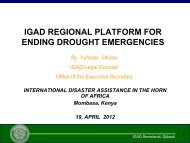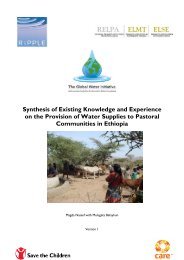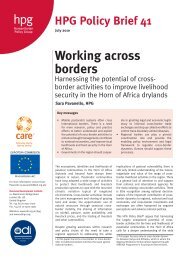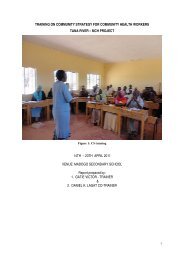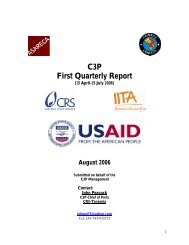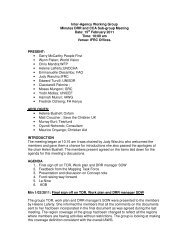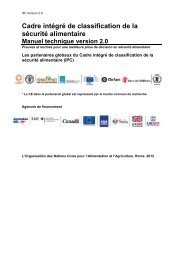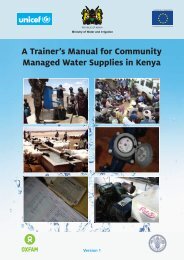Workshop on Early Warning Systems in Kenya - Disaster risk reduction
Workshop on Early Warning Systems in Kenya - Disaster risk reduction
Workshop on Early Warning Systems in Kenya - Disaster risk reduction
You also want an ePaper? Increase the reach of your titles
YUMPU automatically turns print PDFs into web optimized ePapers that Google loves.
REPORTONWORKSHOP ON EARLY WARNING SYSTEMS IN KENYAAFRICAN ADVANCED LEVEL TELECOMMUNICATIONS INSTITUTENAIROBI, KENYA: 4 OCTOBER 2006LINKS/Global Livestock CRSPP.O. Box 30709-00100Nairobi, <strong>Kenya</strong>Tel: 254-20-4223407Fax: 254-20-4223001November 2006
Table of c<strong>on</strong>tentsPageAbbreviati<strong>on</strong>s..................................................................................................................... ivIntroducti<strong>on</strong>..........................................................................................................................1Open<strong>in</strong>g Remarks ................................................................................................................3<str<strong>on</strong>g>Workshop</str<strong>on</strong>g> Open<strong>in</strong>g Speech .................................................................................................4C<strong>on</strong>text and Theme of the <str<strong>on</strong>g>Workshop</str<strong>on</strong>g>..................................................................................7Global Livestock CRSP Livestock <strong>Early</strong> <strong>Warn<strong>in</strong>g</strong> System...............................................10Perspective <strong>on</strong> FEWS NET Analytical Approaches <strong>in</strong> the Greater Horn of Africa..........15The Community Based Livestock <strong>Early</strong> <strong>Warn<strong>in</strong>g</strong> System ................................................18CORDAID Approach <strong>in</strong> Drought and <strong>Disaster</strong> Management ...........................................22Role of FVA <strong>in</strong> Deliver<strong>in</strong>g Informati<strong>on</strong> to Remote Areas of Eastern Africa....................24Group Tasks.......................................................................................................................27Future of Livestock <strong>Early</strong> <strong>Warn<strong>in</strong>g</strong> <strong>in</strong> <strong>Kenya</strong>....................................................................32Way Forward .....................................................................................................................33References..........................................................................................................................34Appendix I: List of Participants.........................................................................................35Appendix II: <str<strong>on</strong>g>Workshop</str<strong>on</strong>g> Program ......................................................................................37Appendix III: Access<strong>in</strong>g LEWS/GL-CRSP Forage <strong>Early</strong> <strong>Warn<strong>in</strong>g</strong> <strong>on</strong> Internet ...............38iii
Abbreviati<strong>on</strong>sAARNETADBAFRALTIALRMPASALAU-IBARCB-LEWSCBOCHARMCICCMOCMPCNRITCORDAIDDCMDLPODPPBDVOENSDAEROSEWSFAOFEWS NETFVAGISGL-CRSPGPSKFSMLEWSLINKSMODISMoLFDNARSNDVINGONOAAPARIMAPCUSMSTAMUUSAIDUSGSAnimal Agriculture Research NetworkAfrican Development BankAfrican Advanced Level Telecommunicati<strong>on</strong>s InstituteArid Lands Resource Management ProjectArid and Semi Arid LandsAfrican Uni<strong>on</strong> Interafrican Bureau <strong>on</strong> Animal ResourcesCommunity Based Livestock <strong>Early</strong> <strong>Warn<strong>in</strong>g</strong> SystemCommunity Based Organizati<strong>on</strong>Collaborative Historical African Ra<strong>in</strong>fall ModelCommunity Informati<strong>on</strong> CenterCrisis Mitigati<strong>on</strong> OfficeCrisis Mitigati<strong>on</strong> ProjectCenter for Natural Resource Informati<strong>on</strong> TechnologyCatholic Organizati<strong>on</strong> for Development AidDrought Cycle ManagementDistrict Livestock Producti<strong>on</strong> Officer<strong>Disaster</strong> Preparedness and Preventi<strong>on</strong> Bureau, EthiopiaDistrict Veter<strong>in</strong>ary OfficerEwaso Nyiro South Development AuthorityEarth Resources Observati<strong>on</strong> System<strong>Early</strong> <strong>Warn<strong>in</strong>g</strong> SystemFood and Agriculture Organizati<strong>on</strong>Fam<strong>in</strong>e <strong>Early</strong> <strong>Warn<strong>in</strong>g</strong> <strong>Systems</strong> NetworkFirst Voice AfricaGeographic Informati<strong>on</strong> SystemGlobal Livestock Collaborative Research Support ProgramGlobal Positi<strong>on</strong><strong>in</strong>g System<strong>Kenya</strong> Food Security Meet<strong>in</strong>gLivestock <strong>Early</strong> <strong>Warn<strong>in</strong>g</strong> SystemLivestock Informati<strong>on</strong> Network and Knowledge SystemModerate Resoluti<strong>on</strong> Imag<strong>in</strong>g SpectroradiometerM<strong>in</strong>istry of Livestock and Fisheries DevelopmentNati<strong>on</strong>al Agricultural Research SystemNormalized Difference Vegetati<strong>on</strong> IndexN<strong>on</strong> Governmental Organizati<strong>on</strong>Nati<strong>on</strong>al Oceanic and Atmospheric Adm<strong>in</strong>istrati<strong>on</strong>Pastoral Risk ManagementProject Coord<strong>in</strong>ati<strong>on</strong> UnitSimple Message ServiceTexas Agriculture and Mechanizati<strong>on</strong> UniversityUnited States Agency for Internati<strong>on</strong>al DevelopmentUnited States Geological Surveyiv
Introducti<strong>on</strong>Be<strong>in</strong>g home to some of the poorest and most marg<strong>in</strong>alized people and majority oflivestock, arid and semi-arid lands are ga<strong>in</strong><strong>in</strong>g <strong>in</strong>creas<strong>in</strong>g attenti<strong>on</strong> of government,development partners, and civil society organizati<strong>on</strong>s. These areas are characterized byrepeated occurrences of drought and high variability <strong>in</strong> precipitati<strong>on</strong> and a comb<strong>in</strong>ati<strong>on</strong> ofthese and other factors has reduced the ability of many livestock keepers to ma<strong>in</strong>ta<strong>in</strong> theirassets or to resp<strong>on</strong>d before c<strong>on</strong>diti<strong>on</strong>s deteriorate. Repeated analysis supports argumentsfor a more effective spatially coherent early warn<strong>in</strong>g system <strong>in</strong> the country, especially asit affects livestock throughout the pastoral and mixed farm<strong>in</strong>g regi<strong>on</strong>s. The judicious useof timely and reliable early warn<strong>in</strong>g <strong>in</strong>formati<strong>on</strong> is useful <strong>in</strong> reduc<strong>in</strong>g and manag<strong>in</strong>g <strong>risk</strong>ssuch as droughts that often reduce assets as part of the soluti<strong>on</strong> to alleviate food<strong>in</strong>security. Crisis preventi<strong>on</strong> <strong>in</strong>volves the ability to foresee and the means to prevent,prepare for and mitigate or resolve crisis and c<strong>on</strong>flict. More important, however, is tostrengthen peoples’ capacity to be able to plan ahead by mak<strong>in</strong>g <strong>in</strong>formed decisi<strong>on</strong>s thatwill m<strong>in</strong>imize the debilitat<strong>in</strong>g effects of drought. This capacity can be strengthened atthree levels: policy, agency, and community.A number of organizati<strong>on</strong>s are engaged <strong>in</strong> provid<strong>in</strong>g early warn<strong>in</strong>g <strong>in</strong>formati<strong>on</strong> that canhelp livestock keepers to cope with drought. These <strong>in</strong>clude the Livestock Informati<strong>on</strong>Network and Knowledge System (LINKS) of the Global Livestock CollaborativeResearch Support Program, Arid Lands Resource Management Project (ALRMP),Fam<strong>in</strong>e <strong>Early</strong> <strong>Warn<strong>in</strong>g</strong> <strong>Systems</strong> Network (FEWS NET) and the ADB/ASAL basedSupport to Livestock and Rural Livelihoods Project of the M<strong>in</strong>istry of Livestock andFisheries Development (MoLFD). LINKS has developed technologies for provid<strong>in</strong>g alivestock early warn<strong>in</strong>g system <strong>on</strong> forage and drought c<strong>on</strong>diti<strong>on</strong>s for pastoral livestockproducers that depict forage scenarios every 10 days and forecast<strong>in</strong>g what the foragesituati<strong>on</strong> is likely to be 30, 60, and 90 days <strong>in</strong>to the future. The system is based <strong>on</strong> datafrom geo-referenced m<strong>on</strong>itor<strong>in</strong>g sites which are analyzed and synthesized throughautomated models and then broadcasted via satellite, thus reduc<strong>in</strong>g the need for human<strong>in</strong>terventi<strong>on</strong> <strong>in</strong> data collecti<strong>on</strong>, analysis, synthesis, and dissem<strong>in</strong>ati<strong>on</strong>; often a laborious,<strong>in</strong>efficient, time-c<strong>on</strong>sum<strong>in</strong>g and expensive exercise. The natural resources and droughtmanagement comp<strong>on</strong>ent of the ALRMP aims to mitigate the <strong>risk</strong> posed by drought andother factors by strengthen<strong>in</strong>g and <strong>in</strong>stituti<strong>on</strong>aliz<strong>in</strong>g natural resources and droughtmanagement systems. This <strong>in</strong> turn will reduce the vulnerability of the populati<strong>on</strong> <strong>in</strong> areascharacterized by frequent acute food <strong>in</strong>security related to drought. The early warn<strong>in</strong>gsystem is based <strong>on</strong> field m<strong>on</strong>itor<strong>in</strong>g of <strong>in</strong>dicators of drought, <strong>in</strong>clud<strong>in</strong>g livestock prices, atthe household level with data be<strong>in</strong>g synthesized at the district level.The goal of FEWS NET is to strengthen the abilities of African countries and regi<strong>on</strong>alorganizati<strong>on</strong>s to manage <strong>risk</strong> of food <strong>in</strong>security through the provisi<strong>on</strong> of timely andanalytical early warn<strong>in</strong>g and vulnerability <strong>in</strong>formati<strong>on</strong>. FEWS NET collaborates with<strong>in</strong>ternati<strong>on</strong>al, nati<strong>on</strong>al, and regi<strong>on</strong>al partners to provide timely and rigorous early warn<strong>in</strong>gand vulnerability <strong>in</strong>formati<strong>on</strong> <strong>on</strong> emerg<strong>in</strong>g or evolv<strong>in</strong>g food security issues. Data and<strong>in</strong>formati<strong>on</strong> m<strong>on</strong>itored <strong>in</strong>clude remotely sensed data and ground-based meteorological,
<str<strong>on</strong>g>Workshop</str<strong>on</strong>g> Open<strong>in</strong>g SpeechProgramme directors,Project coord<strong>in</strong>ators,Ladies and gentlemen;I am pleased to be here with you this morn<strong>in</strong>g dur<strong>in</strong>g the official open<strong>in</strong>g of thisworkshop <strong>on</strong> early warn<strong>in</strong>g systems. I wish to express my appreciati<strong>on</strong> to the GlobalLivestock Collaborative Research Support Program LINKS/Livestock <strong>Early</strong> <strong>Warn<strong>in</strong>g</strong>System for coord<strong>in</strong>at<strong>in</strong>g the process lead<strong>in</strong>g to this occasi<strong>on</strong> for a job well d<strong>on</strong>e. It is alsoimportant to acknowledge the roles played by other organizati<strong>on</strong>s towards this occasi<strong>on</strong>.These <strong>in</strong>clude: the ASAL based Livestock and Rural Livelihoods Support Project,Cordaid and C<strong>on</strong>cern Worldwide. We look forward to the strengthen<strong>in</strong>g of this type ofcollaborati<strong>on</strong> and also the widen<strong>in</strong>g of participati<strong>on</strong> by other players <strong>in</strong> such activities.Ladies and gentlemen:This workshop comes at a time when our country has just emerged from a seriousdrought that threatened assets and livelihoods of many communities especially am<strong>on</strong>gpastoral communities where livestock are the source of subsistence and <strong>in</strong>come. As it isnow, many areas have not yet recovered from the impacts of this drought. As we all knowpastoralism is the dom<strong>in</strong>ant way of life <strong>in</strong> districts fall<strong>in</strong>g under the arid and semi-aridlands of <strong>Kenya</strong>. These districts account for about 30% of the country’s populati<strong>on</strong> andoccupy over 80% of the total land area and hold over 50% of all livestock. Only severaldecades back, pastoralists were the primary users of our rangelands. Strategies such asmobility, match<strong>in</strong>g livestock species to the envir<strong>on</strong>ment and herd splitt<strong>in</strong>g ensured theirsurvival as well as the dynamic equilibrium of the ecosystem. Under such c<strong>on</strong>diti<strong>on</strong>senvir<strong>on</strong>mental degradati<strong>on</strong> was <strong>in</strong>significant. However, human and livestock populati<strong>on</strong>shave tremendously <strong>in</strong>creased over the years. Pastoralists have lost their most valuablegraz<strong>in</strong>g resources to other uses and tenure systems such as agriculture, game reserves andprivate ranches. This has greatly c<strong>on</strong>stra<strong>in</strong>ed pastoral mobility and eroded the rangelands’ability to support the <strong>in</strong>creas<strong>in</strong>g sedentary pastoral populati<strong>on</strong>. The overall trend <strong>in</strong> theserangelands is depicted by decreas<strong>in</strong>g productivity, <strong>in</strong>creas<strong>in</strong>g degradati<strong>on</strong> anddim<strong>in</strong>ish<strong>in</strong>g ability to cope with ecological stress.It is important to note that the frequency and length of drought periods have c<strong>on</strong>t<strong>in</strong>ued to<strong>in</strong>crease <strong>in</strong> many parts of the country. This is aggravated by high variability <strong>in</strong> theamount and spread of ra<strong>in</strong>fall reduc<strong>in</strong>g the ability of many livestock keepers to ma<strong>in</strong>ta<strong>in</strong>their assets or to resp<strong>on</strong>d when c<strong>on</strong>diti<strong>on</strong>s are good.Ladies and gentlemenA number of organizati<strong>on</strong>s are engaged <strong>in</strong> provid<strong>in</strong>g early warn<strong>in</strong>g <strong>in</strong>formati<strong>on</strong> that canhelp livestock keepers cope with drought. Key am<strong>on</strong>g these <strong>in</strong>cludes the GlobalLivestock Collaborative Research Support Program, the Arid Lands ResourceManagement Project, FEWS NET, and the recently launched Community BasedLivestock <strong>Early</strong> <strong>Warn<strong>in</strong>g</strong> System.4
• The GL-CRSP LINKS/LEWS project has developed models for depict<strong>in</strong>g foragescenarios every 10 days and forecast<strong>in</strong>g what the forage situati<strong>on</strong> is likely to be 30, 60,and 90 days <strong>in</strong>to the future. The outputs from the system are used to generate advisoriesusable by agencies and communities of livestock producers.• The ALRMP early warn<strong>in</strong>g system is based <strong>on</strong> field m<strong>on</strong>itor<strong>in</strong>g of <strong>in</strong>dicators ofdrought, <strong>in</strong>clud<strong>in</strong>g livestock prices, at the household level with data be<strong>in</strong>g synthesizedat the district level.• FEWS NET collaborates with nati<strong>on</strong>al, regi<strong>on</strong>al and <strong>in</strong>ternati<strong>on</strong>al partners to providetimely early warn<strong>in</strong>g and vulnerability <strong>in</strong>formati<strong>on</strong> <strong>on</strong> emerg<strong>in</strong>g or evolv<strong>in</strong>g foodsecurity issues.• The CB-LEWS project of the ADB/ASAL project is support<strong>in</strong>g the sett<strong>in</strong>g up ofcommunity-based livestock early warn<strong>in</strong>g systems <strong>in</strong> 14 districts. It will also supportthe build<strong>in</strong>g of capacities of pastoral communities to develop, launch and susta<strong>in</strong>cop<strong>in</strong>g strategies dur<strong>in</strong>g crises. In additi<strong>on</strong> the project will f<strong>in</strong>ance tra<strong>in</strong><strong>in</strong>g andequipp<strong>in</strong>g of site m<strong>on</strong>itors and <strong>in</strong>stituti<strong>on</strong>s <strong>in</strong>volved <strong>in</strong> manag<strong>in</strong>g climate change anddrought crises <strong>in</strong> the ASALS.Ladies and gentlemen:Provid<strong>in</strong>g <strong>in</strong>formati<strong>on</strong> <strong>on</strong> impend<strong>in</strong>g drought <strong>in</strong> sufficient lead-time will allowgovernment, development agencies and pastoral communities to react to the c<strong>on</strong>diti<strong>on</strong>s <strong>in</strong>a timely manner to prevent resource degradati<strong>on</strong> and loss of assets. With regard tolivestock owners, timely decisi<strong>on</strong> mak<strong>in</strong>g c<strong>on</strong>cern<strong>in</strong>g availability of forage supply,movement, de-stock<strong>in</strong>g and restock<strong>in</strong>g of livestock will be valuable for susta<strong>in</strong>ablelivestock producti<strong>on</strong>. In additi<strong>on</strong> the <strong>in</strong>digenous knowledge of the pastoral societiesregard<strong>in</strong>g range and livestock will be much more effective if they can have access to nearreal-time <strong>in</strong>formati<strong>on</strong> <strong>on</strong> impend<strong>in</strong>g forage shortages for livestock and locati<strong>on</strong> of foragesupplies that m<strong>in</strong>imizes c<strong>on</strong>flict dur<strong>in</strong>g periods of restrictive c<strong>on</strong>diti<strong>on</strong>s. In actual fact acomb<strong>in</strong>ati<strong>on</strong> of the <strong>in</strong>digenous knowledge and modern science can be used by decisi<strong>on</strong>makers to formulate clear mitigati<strong>on</strong> strategies to reduce <strong>risk</strong> from extremes of weatherc<strong>on</strong>diti<strong>on</strong>s.Ladies and gentlemen:A key challenge is how to strengthen the use of the livestock early warn<strong>in</strong>g <strong>in</strong>formati<strong>on</strong>by key organizati<strong>on</strong>s and broaden the coverage and dissem<strong>in</strong>ati<strong>on</strong> am<strong>on</strong>g pastoralcommunities. Equipp<strong>in</strong>g agencies and communities with appropriate tools and<strong>in</strong>formati<strong>on</strong> will help them plan for and resp<strong>on</strong>d to emerg<strong>in</strong>g drought situati<strong>on</strong>s. This isbased <strong>on</strong> the firm belief that if the right <strong>in</strong>stituti<strong>on</strong>s and mechanisms are put <strong>in</strong> place,most drought-associated disasters that are currently fac<strong>in</strong>g many communities could bemitigated, provid<strong>in</strong>g communities with susta<strong>in</strong>able means of meet<strong>in</strong>g the demands forfood and other basic necessities of life.This workshop provides the opportunity for stakeholders to explore ways of build<strong>in</strong>gearly warn<strong>in</strong>g capacities am<strong>on</strong>g communities of livestock keepers and help to packageand dissem<strong>in</strong>ate the <strong>in</strong>formati<strong>on</strong> to the relevant target groups. I wish to express mys<strong>in</strong>cere wish that key c<strong>on</strong>cerns regard<strong>in</strong>g early warn<strong>in</strong>g system will be discussed and theway forward agreed. One of these is the fact there are many players but the collaborati<strong>on</strong>5
and <strong>in</strong>teracti<strong>on</strong>s are somehow limited. Collaborati<strong>on</strong> needs to be strengthened,<strong>in</strong>formati<strong>on</strong> should be shared widely and discussi<strong>on</strong>s of this nature more frequent. Indo<strong>in</strong>g so we shall realize synergies from the <strong>in</strong>vestments from <strong>in</strong>dividual organizati<strong>on</strong>s.We all know that at the end of the day we are all basically target<strong>in</strong>g the same group butunfortunately do<strong>in</strong>g it without sufficient regard to the role of our partners.I now wish to c<strong>on</strong>clude by express<strong>in</strong>g our appreciati<strong>on</strong> for the c<strong>on</strong>tributi<strong>on</strong> that has beenmade by all development agencies <strong>in</strong> this area. I also wish to express my appreciati<strong>on</strong> forthe role that staff <strong>in</strong> the M<strong>in</strong>istry and the community have played <strong>in</strong> this process. I hopethat this cooperati<strong>on</strong> will c<strong>on</strong>t<strong>in</strong>ue and enable the realizati<strong>on</strong> of our broad nati<strong>on</strong>alobjectives and <strong>in</strong> the delivery of quality and prompt services to the people that we serve.Ladies and gentlemen, it is now my pleasure to declare this workshop officially open.Thank you.J. KiptarusDirector of Livestock Producti<strong>on</strong>6
C<strong>on</strong>text and Theme of the <str<strong>on</strong>g>Workshop</str<strong>on</strong>g>Gatarwa Kariuki, LINKSBackground• Track<strong>in</strong>g rangeland envir<strong>on</strong>ment <strong>in</strong> a predictive manner (early warn<strong>in</strong>g) is usually thefirst key step towards effective mitigati<strong>on</strong> and <strong>in</strong>terventi<strong>on</strong>.• Pastoralists <strong>in</strong> eastern Africa have dem<strong>on</strong>strated an ability to describe theirenvir<strong>on</strong>ment/recognize drought, but unable to use <strong>in</strong>formati<strong>on</strong> <strong>in</strong> a predictive manner(Dys<strong>on</strong>-Huds<strong>on</strong> 1991).• Scientists were for years <strong>in</strong>ept at track<strong>in</strong>g the rangeland envir<strong>on</strong>ment <strong>in</strong> a predictivemanner (Dys<strong>on</strong>-Huds<strong>on</strong> 1991).• <strong>Early</strong> <strong>Warn<strong>in</strong>g</strong> <strong>Systems</strong> (EWS) <strong>in</strong>stituted by nati<strong>on</strong>al governments ma<strong>in</strong>ly focused <strong>on</strong>crop producti<strong>on</strong>.• Ra<strong>in</strong>fall and remotely sensed forage situati<strong>on</strong> are the earliest <strong>in</strong>dicators of drought. Andalthough they are not perfect <strong>in</strong>dicators they have capacity to trigger local participatoryassessment and mitigat<strong>in</strong>g strategies.• <strong>Early</strong> warn<strong>in</strong>g supports traditi<strong>on</strong>al cop<strong>in</strong>g strategies such as herd splitt<strong>in</strong>g and stockmovement.• L<strong>in</strong>k<strong>in</strong>g EWS to local disaster mitigati<strong>on</strong> helps to identify and <strong>in</strong>form of potentialthreats early enough, and is more effective for m<strong>in</strong>imiz<strong>in</strong>g loss of assets andlivelihoods. It also reduces vulnerability to natural hazards (see the BackgroundDocument for the Nati<strong>on</strong>al Policy for the Susta<strong>in</strong>able Development of ASALS of<strong>Kenya</strong>, September 2005 and MoLFD Taskforce Report, August 2006). <strong>Early</strong><strong>in</strong>terventi<strong>on</strong>s are therefore the most cost-effective approach to food security.• L<strong>in</strong>k<strong>in</strong>g markets with early warn<strong>in</strong>g can facilitate resp<strong>on</strong>se to disaster situati<strong>on</strong>s andallows phased resp<strong>on</strong>se such as early disposal of n<strong>on</strong>-essential livestock, cost-effectivedestock<strong>in</strong>g strategies.• Droughts are the result of decl<strong>in</strong><strong>in</strong>g or lack of ra<strong>in</strong>fall which affects plant growth andtherefore forage availability. Next to be affected are the livestock and through the foodcha<strong>in</strong> people are affected by lack of sufficient food either from plants or animals. Therati<strong>on</strong>ale then is that protect<strong>in</strong>g livelihoods first rather than people is the cheaper opti<strong>on</strong>as <strong>in</strong>dicated below.Cost of 1999-2000 drought <strong>in</strong> <strong>Kenya</strong> (US$ milli<strong>on</strong>)Actual drought costs 300.0Value of livestock lost 38.6Cost of current EWS 5.0Total drought costs 343.6Potential cost given appropriate early resp<strong>on</strong>seCost of EWS with rapid emergency resp<strong>on</strong>se capacity 51.9Cost of subsequent essential relief 120.0Total necessary costs 171.9Potential sav<strong>in</strong>gs 171.6 (50%)Source: Acacia C<strong>on</strong>sultants, 2001: Drought related livestock <strong>in</strong>terventi<strong>on</strong>s report,November 20017
ChallengesManag<strong>in</strong>g crises and disasters are part of reduc<strong>in</strong>g vulnerability, improv<strong>in</strong>g food securityand livelihoods to alleviate poverty and therefore c<strong>on</strong>tribute to overall social andec<strong>on</strong>omic development. Debates about the role and c<strong>on</strong>tributi<strong>on</strong> of early warn<strong>in</strong>g to thisprocess c<strong>on</strong>t<strong>in</strong>ue to occupy the th<strong>in</strong>k<strong>in</strong>g of policy makers, researchers, developmentagencies, n<strong>on</strong>-governmental and community-based organizati<strong>on</strong>s <strong>in</strong>volved <strong>in</strong> design,plann<strong>in</strong>g and implementati<strong>on</strong> of programs and policies aimed at achiev<strong>in</strong>g developmentfor the larger populati<strong>on</strong>. This is especially so follow<strong>in</strong>g the serious drought that ravagedmany parts of <strong>Kenya</strong> between September 2005 and March 2006 and whose effectsc<strong>on</strong>t<strong>in</strong>ue to be felt as at the hold<strong>in</strong>g of this workshop. The follow<strong>in</strong>g observati<strong>on</strong>s,c<strong>on</strong>cerns, and challenges, am<strong>on</strong>g many others <strong>in</strong> the past and at present, are food forthought <strong>in</strong> terms of what is there and what needs to be d<strong>on</strong>e to reduce the perniciouseffects of drought <strong>on</strong> assets and livelihoods now and <strong>in</strong> the future.• “…acute food <strong>in</strong>security <strong>on</strong>ly becomes newsworthy when fam<strong>in</strong>e is imm<strong>in</strong>ent or alreadypresent and the pictures are guaranteed to shock. It is of little use for publiciz<strong>in</strong>g genu<strong>in</strong>eearly warn<strong>in</strong>g…” Margaret Buchanan-Smith. Role of <strong>Early</strong> <strong>Warn<strong>in</strong>g</strong> <strong>Systems</strong> <strong>in</strong>Decisi<strong>on</strong> Mak<strong>in</strong>g Processes. Overseas Development Institute, L<strong>on</strong>d<strong>on</strong>.http://www.drought.unl.edu.m<strong>on</strong>itor/EWS/ch2_Buchanan-Smith.pdf• “In <strong>Kenya</strong>, why does this keep happen<strong>in</strong>g?” Emily Wax. Wash<strong>in</strong>gt<strong>on</strong> Post ForeignService. Sunday, January 8, 2006. http://www.wash<strong>in</strong>gt<strong>on</strong>post.com/wpdyn/c<strong>on</strong>tent/article/2006/01/07/AR2006010701024.html.• “…How come we have m<strong>on</strong>ey to feed people dur<strong>in</strong>g emergencies but we do not havem<strong>on</strong>ey for preventive acti<strong>on</strong>?” Prof. Wangarĩ Maathai, 10 May 2006.These issues br<strong>in</strong>g to the forefr<strong>on</strong>t the need to renew and reorient th<strong>in</strong>k<strong>in</strong>g and acti<strong>on</strong>,focus<strong>in</strong>g <strong>on</strong> what the priorities are, <strong>in</strong>stituti<strong>on</strong>al memories, beauracracy, and capacities tomanage crises.Emerg<strong>in</strong>g issuesIt is important to note that <strong>in</strong> the c<strong>on</strong>text of operati<strong>on</strong>aliz<strong>in</strong>g early warn<strong>in</strong>g systems:• “<strong>Early</strong>” must be functi<strong>on</strong>al <strong>in</strong> terms of be<strong>in</strong>g proactive rather than reactive andprovid<strong>in</strong>g a sufficient lead time for acti<strong>on</strong>.• A predicted phenomen<strong>on</strong> may or may not occur, but people should be warned andprepared.• Timel<strong>in</strong>ess <strong>in</strong> report<strong>in</strong>g is crucial. <strong>Early</strong> warn<strong>in</strong>g systems must have a sell-by date sothat feedback is also delivered <strong>in</strong> good time.8
• High-tech approaches are not necessarily bad. S<strong>in</strong>ce <strong>in</strong>formati<strong>on</strong> flow does not depend<strong>on</strong> a s<strong>in</strong>gle delivery mode explore opportunities for complementarities.• For susta<strong>in</strong>ability of a system, there is need to recognize that noth<strong>in</strong>g is free as some<strong>on</strong>ehas to foot the bill.• There will be greater positive impacts if community <strong>in</strong>volvement is <strong>in</strong>tensified andwhen communities are empowered through access to reliable and timely <strong>in</strong>formati<strong>on</strong>.<str<strong>on</strong>g>Workshop</str<strong>on</strong>g> objectives• Identify and evaluate the characteristics of different early warn<strong>in</strong>g systems with respectto their design, structure, costs, and outputs.• Evaluate the methodologies used <strong>in</strong> data collecti<strong>on</strong>, report<strong>in</strong>g, and analysis.• Evaluate the methods used to dissem<strong>in</strong>ate early warn<strong>in</strong>g <strong>in</strong>formati<strong>on</strong>.• Explore opportunities for capacity build<strong>in</strong>g at local level so as to l<strong>in</strong>k early warn<strong>in</strong>gwith decisi<strong>on</strong> mak<strong>in</strong>g by communities.• Situate the future of early warn<strong>in</strong>g systems <strong>in</strong> terms of the <strong>in</strong>stituti<strong>on</strong>al and policyissues that need to be addressed.9
• PHYGROW-this is the ma<strong>in</strong> model which is hydrology-based, and <strong>in</strong>tegrates spatiallyexplicit multiple-species plant growth, hydrology of the site and types of animals.• NUTBAL-a livestock nutriti<strong>on</strong>al balance analyzer used to assess nutrient requirements,nutrient <strong>in</strong>take, and animal performance.• Near Infrared Reflectance Spectroscopy (NIRS)-<strong>in</strong>volves fecal profil<strong>in</strong>g of livestock todeterm<strong>in</strong>e the quality of the forage recently c<strong>on</strong>sumed prior to defecat<strong>in</strong>g.• Spatial characterizati<strong>on</strong> and GIS tools.• NOAA RFE weather data and EROS NDVI data <strong>in</strong> a 8x8 km grid.• Tra<strong>in</strong>ed eyes and earsOverall protocol• The LEWS m<strong>on</strong>itor<strong>in</strong>g and validati<strong>on</strong> process <strong>in</strong>volves <strong>in</strong>tensive use of science,experience, learn<strong>in</strong>g by do<strong>in</strong>g and capacity build<strong>in</strong>g. The <strong>in</strong>itial steps <strong>in</strong>volveestablish<strong>in</strong>g z<strong>on</strong>es of <strong>in</strong>terest by <strong>in</strong>stituti<strong>on</strong>s committed to the process followed bygenerati<strong>on</strong> of z<strong>on</strong>al maps with roads, landmarks, and climatic clusters. Climatecoefficients are then developed and sourc<strong>in</strong>g for daily ra<strong>in</strong>fall, temperature andradiati<strong>on</strong> data is d<strong>on</strong>e. The participat<strong>in</strong>g <strong>in</strong>stituti<strong>on</strong>s then designate z<strong>on</strong>al coord<strong>in</strong>atorswho build teams of site m<strong>on</strong>itors. They also tra<strong>in</strong> coord<strong>in</strong>ators <strong>in</strong> the use of tools<strong>in</strong>clud<strong>in</strong>g GPS, digital cameras, basic computer literacy, use of Worldspace radios, andpreparati<strong>on</strong> of photo guides followed by tra<strong>in</strong><strong>in</strong>g <strong>in</strong> field sampl<strong>in</strong>g and site verificati<strong>on</strong>techniques.• The next steps <strong>in</strong>volve identify<strong>in</strong>g the relevant plant parameters, sourc<strong>in</strong>g plantpreferences for different animals, soil parameters and daily ra<strong>in</strong>fall, temperature andradiati<strong>on</strong> data, develop<strong>in</strong>g graz<strong>in</strong>g restock<strong>in</strong>g and destock<strong>in</strong>g rules, and stabiliz<strong>in</strong>g theparameter files.The PHYGROW model• Characterizes graz<strong>in</strong>gland forage producti<strong>on</strong> <strong>in</strong>volv<strong>in</strong>g multiple plant species<strong>in</strong>teract<strong>in</strong>g with soils, weather and selective graz<strong>in</strong>g.• Dom<strong>in</strong>ant plant community <strong>in</strong> a graz<strong>in</strong>g area is characterized by species <strong>in</strong>itial stand<strong>in</strong>gcrop and percent maximum expressi<strong>on</strong>• Physical characteristics of soils are represented by layers from established soil datafrom EROS FEWS-NET• Typical de-stock/restock rules are derived for “modal” sites based <strong>on</strong> c<strong>on</strong>sensus of localfocus groups.• Establish<strong>in</strong>g field benchmark forage c<strong>on</strong>diti<strong>on</strong>s is d<strong>on</strong>e us<strong>in</strong>g quadrats designed for thePhygrow model. Measurements are taken at 50 locati<strong>on</strong>s al<strong>on</strong>g a 200 m transectresult<strong>in</strong>g <strong>in</strong> 500 sampl<strong>in</strong>g po<strong>in</strong>ts captur<strong>in</strong>g the basal cover of grasses, frequency offorbs us<strong>in</strong>g a 5x5 cm frame, and the true canopy cover of shrubs and trees us<strong>in</strong>g amirror to capture the canopy cover hits al<strong>on</strong>g the transect.• Soil parameters that are c<strong>on</strong>sidered <strong>in</strong>clude water storage capacity, slope, the soil depth,rock factor, saturated hydraulic c<strong>on</strong>ductivity, wet and dry bulk densities, and thevolumetric water c<strong>on</strong>tent of the soil.11
• The plant characteristics <strong>on</strong> site <strong>in</strong>clude the plant name, <strong>in</strong>itial stand<strong>in</strong>g crop,percentage of maximum expressi<strong>on</strong>, and site nutrient factor.• The model takes <strong>in</strong>to account the decisi<strong>on</strong> rules based <strong>on</strong> type of animal <strong>in</strong>clud<strong>in</strong>gdomestic livestock and wildlife, the plann<strong>in</strong>g horiz<strong>on</strong> which is based <strong>on</strong> the Juliancalendar cover<strong>in</strong>g 365 days, maximum and m<strong>in</strong>imum stock<strong>in</strong>g rates, and plantpreferences which are based <strong>on</strong> type of animal, forage demand, and whether the plant ispreferred, desired, or not eaten by the specific animal.• Weather characteristics that are <strong>in</strong>cluded <strong>in</strong> the model <strong>in</strong>clude the site latitude andl<strong>on</strong>gitude coord<strong>in</strong>ates, the year, daily maximum and m<strong>in</strong>imum temperatures, ra<strong>in</strong>falland solar radiati<strong>on</strong>. Ra<strong>in</strong>fall is derived from the Collaborative Historical AfricanRa<strong>in</strong>fall Model (CHARM) which provides data <strong>on</strong> a daily basis s<strong>in</strong>ce 1961.Field verificati<strong>on</strong>• Undertaken at regular <strong>in</strong>tervals to test whether the models are accurately simulat<strong>in</strong>g thefield forage c<strong>on</strong>diti<strong>on</strong>s• This is d<strong>on</strong>e us<strong>in</strong>g 5 – 50 m transects with 10 quadrats each allocated to representativeareas with double sampl<strong>in</strong>g us<strong>in</strong>g dry weight rank<strong>in</strong>g and clipp<strong>in</strong>g a total 15 of 50quadrats <strong>in</strong> 8x8 km grid• The correcti<strong>on</strong> coefficient between predicted and observed forage is 0.94 as shown <strong>in</strong>the figure <strong>on</strong> the right.4000P r e d i c t e d H e r b a c e o u s S t a n d i n g C r o p ( k g / h a )350030002500200015001000R 2 = 0.94SEP = 189n=45500LEWS scientists collect<strong>in</strong>g data for field validati<strong>on</strong>F<strong>in</strong>al analysis00500 1000 1500 2000 2500 3000 3500 4000Observed Herbaceous Stand<strong>in</strong>g Crop (kg/ha)• Model parameters are reviewed and adjusted to correct discrepancies between fieldverificati<strong>on</strong> and model output.• Once the model is stable for each po<strong>in</strong>t, the parameter file is placed <strong>in</strong> the automati<strong>on</strong>site where the model is l<strong>in</strong>ked with the satellite weather data and output packaged <strong>in</strong>tohtml files for distributi<strong>on</strong> over the <strong>in</strong>ternet and to key communicati<strong>on</strong> nodes us<strong>in</strong>gWorldspace satellite radios.• Advisories for <strong>Kenya</strong>, Ethiopia, Tanzania and Uganda are provided <strong>on</strong> a m<strong>on</strong>thly basis.The advisory also <strong>in</strong>cludes a trend analysis of livestock prices for a selected market.12
• LEWS generates unique map products provid<strong>in</strong>g forage status <strong>in</strong> each country z<strong>on</strong>esand a regi<strong>on</strong>al forecast 60 days ahead.• The LEWS maps are generated from the PHYGROW model. They are not satelliteimages.• Advisories are sent out to users <strong>in</strong> an expand<strong>in</strong>g listserve through e-mail and alsoposted to the LEWS website http://glews.tamu.edu.tamu/africa (see appendix III <strong>on</strong>how to locate different sites and products).• Community outreach designed to create awareness and empower communities to makedecisi<strong>on</strong>s based <strong>on</strong> the advisories.• LEWS c<strong>on</strong>tributes to the Greater Horn of Africa Food Security Bullet<strong>in</strong>.• LEWS tracked the September 2005 to March 2006 drought very well.Reacti<strong>on</strong>s• Walter, USAID: To what extent is data collecti<strong>on</strong> c<strong>on</strong>t<strong>in</strong>uous? How is that be<strong>in</strong>gsusta<strong>in</strong>ed now that the LEWS project ended?Resp<strong>on</strong>se: Periodic i.e. every 6 m<strong>on</strong>ths, 25% of the m<strong>on</strong>itor<strong>in</strong>g sites are sampled by theLINKS team, field m<strong>on</strong>itors and z<strong>on</strong>al coord<strong>in</strong>ators. There were many vegetati<strong>on</strong>changes at the various sites, and the project puts <strong>in</strong>to account these changes by send<strong>in</strong>gfield m<strong>on</strong>itors and z<strong>on</strong>al coord<strong>in</strong>ators to verify data <strong>in</strong> the field and this is fed back tothe system.• Kateiya, ENSDA Narok: The R 2 is very high, but the sample size (n) very small. This<strong>in</strong>dicates multi-col<strong>in</strong>earity, mean<strong>in</strong>g the data might have been moderated.Resp<strong>on</strong>se: The data has not been adjusted <strong>in</strong> any way; that is why some po<strong>in</strong>ts arelocated away from the trend l<strong>in</strong>e. This is an old graph; several other field verificati<strong>on</strong>exercises have been c<strong>on</strong>ducted s<strong>in</strong>ce then.• Ouma, DLPO Samburu: There is need to build capacity of the MoLFD especiallydistrict range officers for forage m<strong>on</strong>itor<strong>in</strong>g to be part of their duties. They should knowthe locati<strong>on</strong> of sites be<strong>in</strong>g m<strong>on</strong>itored, do verificati<strong>on</strong> and provide feedback.Resp<strong>on</strong>se: Agreed, this would improve our products.• Ngeiywa, MoLFD: S<strong>in</strong>ce NDVI shows greenness; w<strong>on</strong>’t a pastoralist just take hisanimals where it is <strong>in</strong>dicated green?Resp<strong>on</strong>se: Yes, the map <strong>in</strong>dicates deviati<strong>on</strong> from normal, so green means there isforage for LEWS, but not necessarily for NDVI.• Gide<strong>on</strong>, FEWS NET: The queries <strong>in</strong>dicate there is need for capacity build<strong>in</strong>g for usersto understand the system and how to <strong>in</strong>terpret data from the LEWS products.• Yeg<strong>on</strong>, MoLFD: Is Prosopis spp comm<strong>on</strong>ly referred to as ‘Mathenge’ really a problem?Resp<strong>on</strong>se: Yes, it is a major problem spread<strong>in</strong>g <strong>in</strong> many pastoral areas, while the forageis of very little value to livestock.13
• Mw<strong>on</strong>gela, DVO Mw<strong>in</strong>gi: Is it true that drought is becom<strong>in</strong>g more frequent andsevere?Resp<strong>on</strong>se: True, climate change has occurred due to <strong>in</strong>creased human activity and highlivestock populati<strong>on</strong> lead<strong>in</strong>g to desertificati<strong>on</strong>. We have made a presentati<strong>on</strong> <strong>on</strong> this <strong>in</strong>a different forum.14
Perspective <strong>on</strong> FEWS NET Analytical Approaches <strong>in</strong> the GreaterHorn of AfricaGide<strong>on</strong> Galu, FEWS NETPerspective• Background/C<strong>on</strong>texto Frameworko Network partners• M<strong>on</strong>itor<strong>in</strong>g and analytical approacheso M<strong>on</strong>itor<strong>in</strong>g field and remotely sensed datao Livelihoods based analysiso Development of new decisi<strong>on</strong> support toolso Regular regi<strong>on</strong>-wide field assessments• Capacity build<strong>in</strong>g at nati<strong>on</strong>al/district levelo Technical support <strong>in</strong> food security m<strong>on</strong>itor<strong>in</strong>g and analysis• Major challengeso Availability and reliability of data/partnershipso Understand<strong>in</strong>g livelihoodso Accurate identificati<strong>on</strong> of chr<strong>on</strong>ic vulnerable communities and resp<strong>on</strong>seFEWS NET has resident representatives <strong>in</strong> 18 African countries: Regi<strong>on</strong>al Offices <strong>in</strong>Bamako, Johannesburg and Nairobi. FEWS NET is now go<strong>in</strong>g Global – Afghanistan andCentral America.The FEWS NET visi<strong>on</strong>: To provide decisi<strong>on</strong> makers and planners with accurate, timely,and acti<strong>on</strong>able <strong>in</strong>formati<strong>on</strong> to prevent hunger-related deaths, mitigate food <strong>in</strong>security andto strengthen livelihoods <strong>in</strong> Africa, Central America and the Caribbean, and Afghanistanthrough provid<strong>in</strong>g early warn<strong>in</strong>g <strong>in</strong>formati<strong>on</strong> related to food security threats, develop<strong>in</strong>g<strong>in</strong>formati<strong>on</strong> networks and build<strong>in</strong>g local capacity for <strong>in</strong>formati<strong>on</strong> generati<strong>on</strong> anddissem<strong>in</strong>ati<strong>on</strong>.FEWS NET framework15
PartnersThese <strong>in</strong>clude, am<strong>on</strong>g others, Livestock <strong>Early</strong> <strong>Warn<strong>in</strong>g</strong> System, United States GeologicalSurvey, World Food Program, United States Department of Agriculture, CareInternati<strong>on</strong>al, Regi<strong>on</strong>al Center for Mapp<strong>in</strong>g of Resources for Development, and DesertLocust C<strong>on</strong>trol Organizati<strong>on</strong>.Available resources: remotely sensed products and toolsM<strong>on</strong>itor<strong>in</strong>g and analysis of food security <strong>in</strong>tegrates the latest field and remote sens<strong>in</strong>gdata as well as markets, producti<strong>on</strong>, and other data, and the use of <strong>in</strong>novative locallivelihood analysis to provide an updated analyses of who needs what where. It also<strong>in</strong>cludes m<strong>on</strong>itor<strong>in</strong>g of markets and trade.Capacity build<strong>in</strong>gOver 500 local pers<strong>on</strong>nel tra<strong>in</strong>ed <strong>in</strong> applicati<strong>on</strong>s of remotely sensed products <strong>in</strong>agriculture and water resources, GIS model<strong>in</strong>g and applicati<strong>on</strong>s and stream flowforecast<strong>in</strong>g and flood early warn<strong>in</strong>g. In <strong>Kenya</strong> regi<strong>on</strong>al workshops have been held withover 200 participants tra<strong>in</strong>ed <strong>on</strong> USGS/FEWS NET products and tools, Arc View GISapplicati<strong>on</strong>s, flood early warn<strong>in</strong>g and stream flow forecast<strong>in</strong>g. In Ethiopia 27participants have been tra<strong>in</strong>ed <strong>on</strong> remote sens<strong>in</strong>g and GIS applicati<strong>on</strong>s and 15 <strong>on</strong> floodearly warn<strong>in</strong>g. In southern Sudan 12 participants have been tra<strong>in</strong>ed <strong>on</strong> USGS/FEWSNET tools and products while <strong>in</strong> Djibouti 29 participants have been tra<strong>in</strong>ed <strong>on</strong> remotesens<strong>in</strong>g and GIS applicati<strong>on</strong>s. In Somalia 26 local participants were tra<strong>in</strong>ed <strong>on</strong>USGS/FEWS NET products and tools and <strong>in</strong> Tanzania 12 participants were tra<strong>in</strong>ed <strong>on</strong>river flow forecast<strong>in</strong>g and flood early warn<strong>in</strong>g. In Rwanda 22 participants were tra<strong>in</strong>ed<strong>on</strong> remote sens<strong>in</strong>g and GIS applicati<strong>on</strong>s while <strong>in</strong> Uganda, 14 participants have beentra<strong>in</strong>ed <strong>on</strong> USGS/FEWS NET products and tools and 15 participants <strong>on</strong> flood early16
warn<strong>in</strong>g and forecast<strong>in</strong>g. Regular field assessments are c<strong>on</strong>ducted for productvalidati<strong>on</strong>.Dissem<strong>in</strong>at<strong>in</strong>g the analysisThis <strong>in</strong>cludes <strong>in</strong>formati<strong>on</strong> products, regi<strong>on</strong>al reports, executive overviews, alertstatements, and special market reports to <strong>in</strong>form decisi<strong>on</strong> mak<strong>in</strong>g.Challenges• Availability and reliability of data• Understand<strong>in</strong>g livelihoods• Accurate identificati<strong>on</strong> of chr<strong>on</strong>ic vulnerable communities and resp<strong>on</strong>se17
The Community Based Livestock <strong>Early</strong> <strong>Warn<strong>in</strong>g</strong> SystemKisa Ngeiywa, MoLFDCB-LEWS project structureOverall objectiveTo ensure that efficient c<strong>on</strong>t<strong>in</strong>gency plans and pragmatic mechanisms for <strong>in</strong>terventi<strong>on</strong>sare put <strong>in</strong> place and utilized to deal with crisis situati<strong>on</strong>s affect<strong>in</strong>g pastoral communities<strong>in</strong> <strong>Kenya</strong>.Expected outputs• An efficient early warn<strong>in</strong>g system is established and utilized to trigger timely<strong>in</strong>terventi<strong>on</strong>s by all stakeholders to mitigate the effects of crises <strong>on</strong> pastoralists’ herdsand livelihoods.• Envir<strong>on</strong>mentally sound c<strong>on</strong>t<strong>in</strong>gency plans enacted to improve livestock productivityand ensure appropriate <strong>in</strong>terventi<strong>on</strong>• Market opportunities and systems that will stabilize the terms of trade for livestockproducers dur<strong>in</strong>g crises are identified, as well as market opportunities for livestock andlivestock products• Pastoral capacity for anticipat<strong>in</strong>g and manag<strong>in</strong>g crises is enhancedPartnerships18
Implementati<strong>on</strong> stepsStep 1: Nati<strong>on</strong>al plann<strong>in</strong>g meet<strong>in</strong>g• Work plan for 2006• Revised survey <strong>in</strong>struments• Del<strong>in</strong>eated provisi<strong>on</strong>al z<strong>on</strong>es• Deliberated <strong>on</strong> the CB-LEWS project structureStep 2: Rec<strong>on</strong>naissance missi<strong>on</strong>• Validati<strong>on</strong> of characterised clusters• Identificati<strong>on</strong> of benchmark sites• Georeferenc<strong>in</strong>g of sample natural resources• Inventory of z<strong>on</strong>e hardware/software resources• Establishment of z<strong>on</strong>e management committees with <strong>in</strong>terim chairpers<strong>on</strong>s• Identificati<strong>on</strong> of z<strong>on</strong>e lead <strong>in</strong>stitutes• Expand potential partnership networks with the z<strong>on</strong>e• Characterizati<strong>on</strong> of sample communitiesStep 3: Stakeholder sensitisati<strong>on</strong> and analysis workshop• Sensitisati<strong>on</strong>• Listen<strong>in</strong>g• Network<strong>in</strong>g• Incorporati<strong>on</strong>• Analysis• Proceed<strong>in</strong>gsStep 4: Capacity build<strong>in</strong>g• Demand driven computer upgrade course• Geo-spatial data capture, GIS and remote sens<strong>in</strong>g tra<strong>in</strong><strong>in</strong>g• Survey <strong>in</strong>struments adm<strong>in</strong>istrati<strong>on</strong>• Worldspace communicati<strong>on</strong> system utilisati<strong>on</strong> tra<strong>in</strong><strong>in</strong>g• Other demand driven tra<strong>in</strong><strong>in</strong>g <strong>in</strong>itiativesStep 5: Resource mapp<strong>in</strong>g and household surveysMapp<strong>in</strong>g• Migrati<strong>on</strong> routes• Market places• Endemic diseases• Resources (water, graz<strong>in</strong>g reserves) al<strong>on</strong>g the major migrati<strong>on</strong> routes as basis fordevelopment and test<strong>in</strong>g potential <strong>in</strong>terventi<strong>on</strong>s and c<strong>on</strong>t<strong>in</strong>gency plans19
Step 6• Validati<strong>on</strong> of GPS Data• Participatory mapp<strong>in</strong>g• Prototype early warn<strong>in</strong>g messages• Feedback workshopsStep 7• Upscal<strong>in</strong>g• Outscal<strong>in</strong>g to n<strong>on</strong>-benchmark site districts• Establish<strong>in</strong>g l<strong>in</strong>kages with other disaster management <strong>in</strong>itiatives <strong>in</strong> the regi<strong>on</strong>• Instituti<strong>on</strong>alizati<strong>on</strong> of the crisis management mechanisms/systems <strong>in</strong>to districtdevelopment plans for takeover by governmentMajor <strong>in</strong>dicators of drought• Meteorologicalo Atmospheric factors that <strong>in</strong>fluence local weather patternso Observati<strong>on</strong> of the follow<strong>in</strong>g phenomena at specific times of the year: str<strong>on</strong>g w<strong>in</strong>dsfrom a given directi<strong>on</strong>, higher than normal temperatures, appearance of morn<strong>in</strong>g dew• Biological/ecologicalo Observed natural changes that occur <strong>in</strong> the local flora and faunao Observati<strong>on</strong> of the follow<strong>in</strong>g phenomena at specific times of the year: flower<strong>in</strong>g,fruit<strong>in</strong>g or leaf shedd<strong>in</strong>g by specific plants at specific times, presence of specific birdsor <strong>in</strong>sects for example ants or butterflies <strong>in</strong> large numbers and migrati<strong>on</strong> of wildanimals.• Astrologicalo Cosmological observati<strong>on</strong>s of the mo<strong>on</strong>, sun and stars• Culturalo Observ<strong>in</strong>g and decipher<strong>in</strong>g patterns <strong>in</strong> the entrails of slaughtered animalso Visi<strong>on</strong>s, appariti<strong>on</strong>s and wise counsel of respected community eldersReacti<strong>on</strong>s• Robert, LINKS: What is the ‘early warn<strong>in</strong>g’ aspect <strong>in</strong> CB-LEWS? From thepresentati<strong>on</strong>, <strong>on</strong>e could not capture the livestock early warn<strong>in</strong>g that CB-LEWS isaddress<strong>in</strong>g. LEWS/GL-CRSP, which is credited with pi<strong>on</strong>eer<strong>in</strong>g livestock earlywarn<strong>in</strong>g, is also not <strong>in</strong>cluded <strong>in</strong> the partnerships chart, unlike PARIMA/GL-CRSP.Resp<strong>on</strong>se: CB-LEWS is be<strong>in</strong>g implemented with<strong>in</strong> the framework of the CrisisMitigati<strong>on</strong> <strong>in</strong> Livestock <strong>Systems</strong> Project (CMP). We are address<strong>in</strong>g many issues <strong>in</strong> CB-LEWS. LEWS/GL-CRSP is <strong>in</strong>cluded under ‘<strong>in</strong>ternati<strong>on</strong>al and regi<strong>on</strong>al EWS’.20
• Abbas, KLMC: A lot of <strong>in</strong>formati<strong>on</strong> exists <strong>in</strong> the databases. What is needed is some<strong>on</strong>eto do the dissem<strong>in</strong>ati<strong>on</strong> for this <strong>in</strong>formati<strong>on</strong> to trickle down to communities. There is n<strong>on</strong>eed for duplicati<strong>on</strong>, but to add value to what others are already do<strong>in</strong>g.• Musyoki, DLPO Makueni: The issue is how to l<strong>in</strong>k <strong>in</strong>formati<strong>on</strong> from all systems,because the <strong>in</strong>formati<strong>on</strong> is not be<strong>in</strong>g used at all.• Suleiman, FEWSNET: There is no ‘early warn<strong>in</strong>g’ <strong>in</strong> overall objective of CB-LEWS,but it is more like <strong>in</strong>terventi<strong>on</strong> plann<strong>in</strong>g. The CB-LEWS team should liaise with otherswork<strong>in</strong>g <strong>on</strong> early warn<strong>in</strong>g to fill gaps rather than end up as duplicati<strong>on</strong>. They shouldensure utilizati<strong>on</strong> of <strong>in</strong>formati<strong>on</strong> generated by others. C<strong>on</strong>sultati<strong>on</strong> seems to be lack<strong>in</strong>g.Resp<strong>on</strong>se: CB-LEWS is open to suggesti<strong>on</strong>s <strong>on</strong> how to improve the livestockcomp<strong>on</strong>ent.• Robert, LINKS: It is difficult to discuss CB-LEWS as those who can make decisi<strong>on</strong>sare not present.• Yeg<strong>on</strong>, MoLFD: I will brief the Director of Livestock Producti<strong>on</strong> <strong>on</strong> the discussi<strong>on</strong>sand what has been agreed. There is need for a str<strong>on</strong>g nati<strong>on</strong>al coord<strong>in</strong>at<strong>in</strong>g <strong>in</strong>stituti<strong>on</strong>for early warn<strong>in</strong>g efforts. There is still time to correct the gaps. From the workshop, weshall talk to <strong>on</strong>e another and get a soluti<strong>on</strong>.• Musili, Represent<strong>in</strong>g Chief Range Management Divisi<strong>on</strong>: Let us explore the issues atdepth dur<strong>in</strong>g group work and chart the way forward.• Safia, CORDAID: LEWS uses advisories to share <strong>in</strong>formati<strong>on</strong>. In which forum willCB-LEWS share the <strong>in</strong>formati<strong>on</strong>?Resp<strong>on</strong>se: Worldspace channel, radio broadcasts <strong>in</strong> Kiswahili and local languages,newsletters, feedback workshops, am<strong>on</strong>g others. Let us all work together such that wecan use the <strong>in</strong>formati<strong>on</strong> generated by others such as LEWS/GL-CRSP.• Muth<strong>on</strong>i, FAO/ALRMP: There is need for all of us to talk together. In <strong>Kenya</strong>, we havevery str<strong>on</strong>g early warn<strong>in</strong>g systems. However, the ma<strong>in</strong> problem is <strong>in</strong> resp<strong>on</strong>se whichthe ADB/ASAL project can address. It is not enough to just take back the reports andadvisories but there is need to facilitate communities to resp<strong>on</strong>d for mitigati<strong>on</strong>. Let ustry to understand and support CB-LEWS.• Mw<strong>on</strong>gela, DVO Mw<strong>in</strong>gi: For CB-LEWS, the emphasis is <strong>on</strong> community-basedmechanisms of predict<strong>in</strong>g and resp<strong>on</strong>d<strong>in</strong>g to drought. They need support from ‘hightech’ systems to improve accuracy and ref<strong>in</strong>e the acti<strong>on</strong>s that the communities can take.• Ouma, DLPO Samburu: How do we get this <strong>in</strong>formati<strong>on</strong> back to those who seek/need<strong>in</strong>formati<strong>on</strong> at local level? There is need for capacity build<strong>in</strong>g to <strong>in</strong>terpret <strong>in</strong>formati<strong>on</strong>for communities and avail tools to partners to work better.21
Introducti<strong>on</strong>CORDAID Approach <strong>in</strong> Drought and <strong>Disaster</strong> ManagementSafia AbdiThe presenter started by reiterat<strong>in</strong>g that her presentati<strong>on</strong> would be different from othersbecause CORDAID does not provide early warn<strong>in</strong>g <strong>in</strong>formati<strong>on</strong>. Her presentati<strong>on</strong> wouldma<strong>in</strong>ly be <strong>on</strong> CORDAID’s drought cycle and disaster <strong>risk</strong> management approaches. Keyhighlights of the presentati<strong>on</strong>.• CORDAID is a Dutch fund<strong>in</strong>g organisati<strong>on</strong>. It does not implement programs albeit <strong>in</strong>some emergency situati<strong>on</strong>s. Rather CORDAID supports organisati<strong>on</strong>s to deliverprograms.• CORDAID gets most of it funds from the Dutch government and the rest from theDutch public and other formal d<strong>on</strong>ors like European Uni<strong>on</strong>.• It supports development and relief organisati<strong>on</strong>s <strong>in</strong> Africa, Lat<strong>in</strong> America, Asia andEastern Europe.• The regi<strong>on</strong>al office <strong>in</strong> <strong>Kenya</strong>covers <strong>Kenya</strong>, Sudan and Ethiopia.• CORDAID supports threestrategies:o Direct poverty alleviati<strong>on</strong>which <strong>in</strong>cludes basic servicedelivery programs like healtho Civil society strengthen<strong>in</strong>go Lobby<strong>in</strong>g and advocacy work• In <strong>Kenya</strong>, CORDAID partners are<strong>in</strong> the urban areas of Nairobi andKisumu, and <strong>in</strong> the ASALs.• The k<strong>in</strong>d of partners <strong>in</strong>cludes a mixSafia Abdi of CORDAID makes her presentati<strong>on</strong>of church and n<strong>on</strong>-church, localNGOs/CBOs and <strong>in</strong>ternati<strong>on</strong>al NGOs, young and mature organisati<strong>on</strong>s.The drought cycle management approachIn its ASAL programs <strong>in</strong> <strong>Kenya</strong> and other countries, CORDAID uses the drought cyclemanagement (DCM) approach. This is not a new approach but is also used by otherorganisati<strong>on</strong>s. The DCM approach takes cognisance of different stages of drought and thedifferent <strong>in</strong>terventi<strong>on</strong>s necessary for the specific stage. Stages as comm<strong>on</strong>ly known arenormal, alert/alarm, emergency and recovery. Dur<strong>in</strong>g normal stage the k<strong>in</strong>ds of programsimplemented are for mitigati<strong>on</strong> purpose, alert is for preparedness, dur<strong>in</strong>g emergency whatis required is for relief assistance, and dur<strong>in</strong>g the recovery stage, the activities are aimedat rec<strong>on</strong>structi<strong>on</strong>.While <strong>on</strong>e cannot clearly demarcate the stages, with a good early warn<strong>in</strong>g system, it ispossible to predict what stage an area is <strong>in</strong> at a particular time. In terms of <strong>in</strong>terventi<strong>on</strong>, it22
is a c<strong>on</strong>t<strong>in</strong>uum where there are cyclically chang<strong>in</strong>g realities with moments of crises andnormality. Those moments will determ<strong>in</strong>e the emphasis of our acti<strong>on</strong> but will not limitthem. Moreover, reliable and accessible EWS is necessary for right target<strong>in</strong>g ofprograms. Thus EWS is essential for fund<strong>in</strong>g organisati<strong>on</strong>s, governments, implement<strong>in</strong>gorganisati<strong>on</strong>s, and the community who always bear the brunt of many hazards.The DCM programCORDAID is currently implement<strong>in</strong>g a DCM program dubbed “right acti<strong>on</strong> at righttime”. This program provides flexible fund<strong>in</strong>g to partner organisati<strong>on</strong>s based <strong>on</strong> thestages of the drought. Before this program, CORDAID with funds from European Uni<strong>on</strong>,and technical <strong>in</strong>put from Internati<strong>on</strong>al Institute for Rural Rec<strong>on</strong>structi<strong>on</strong> and AcaciaC<strong>on</strong>sultants developed a DCM toolkit for use by organisati<strong>on</strong>s <strong>in</strong>clud<strong>in</strong>g governments.<strong>Disaster</strong> <strong>risk</strong> managementCORDAID has accumulated a lot of experiences <strong>in</strong> support<strong>in</strong>g development and reliefprograms especially <strong>in</strong> disaster pr<strong>on</strong>e areas. It is aga<strong>in</strong>st this backdrop that <strong>in</strong> its newstrategic plan, which starts <strong>in</strong> 2007, CORDAID has identified disaster <strong>risk</strong> managementas <strong>on</strong>e of its program areas. This model uses hazards, vulnerability, and capacity as keyc<strong>on</strong>cepts of analysis aimed at reduc<strong>in</strong>g <strong>risk</strong>s and disasters. In today’s world where thereare more c<strong>on</strong>flicts and climate change result<strong>in</strong>g to frequent droughts and floods, thisapproach is essential. CORDAID will <strong>in</strong>vest <strong>in</strong> build<strong>in</strong>g the capacity of it partners tounderstand the model, and implement it <strong>in</strong> their programs.Challenge to the participants• How can we get the early warn<strong>in</strong>g system <strong>in</strong>formati<strong>on</strong> to the grass-root level?• The past practice has been, we extract <strong>in</strong>formati<strong>on</strong> from the communities but we do notdissem<strong>in</strong>ate back.23
Role of FVA <strong>in</strong> Deliver<strong>in</strong>g Informati<strong>on</strong> to Remote Areasof Eastern AfricaAar<strong>on</strong> SundsmoThe missi<strong>on</strong> of First Voice Africa is to provide <strong>in</strong>dividuals across Africa, isolated bygeography, illiteracy or poverty, with the opportunity to receive locally relevant<strong>in</strong>formati<strong>on</strong>, communicate with the world around them and share their experiences withsimilar communities. This by <strong>in</strong>tegrat<strong>in</strong>g technologies, such as broadband global areanetwork, WorldSpace satellite system, solar panels, Internet, AM/FM communityradios, mobile ph<strong>on</strong>es.The opportunity gapChallengesPovertyIsolati<strong>on</strong>/lack of <strong>in</strong>frastructureIlliteracy/poor access to <strong>in</strong>formati<strong>on</strong>Multisectoral• <strong>Early</strong> warn<strong>in</strong>g• Health• Educati<strong>on</strong>• Natural resource management• Ec<strong>on</strong>omic developmentResp<strong>on</strong>seExpand<strong>in</strong>g the rural <strong>in</strong>formati<strong>on</strong>InfrastructureDeliver<strong>in</strong>g relevant c<strong>on</strong>tent• Timely food security and natural disaster<strong>in</strong>formati<strong>on</strong>• HIV awareness and preventi<strong>on</strong>• Distance educati<strong>on</strong>• Weather and climate <strong>in</strong>formati<strong>on</strong>• Market price <strong>in</strong>formati<strong>on</strong>The burden of <strong>in</strong>formati<strong>on</strong> poverty is borne by those most vulnerable to disease,ec<strong>on</strong>omic hardship and isolati<strong>on</strong>.Eastern Ethiopia (Somali and Afar Regi<strong>on</strong>s)Needs• <strong>Early</strong> warn<strong>in</strong>g <strong>in</strong>formati<strong>on</strong> forpastoralists• Food security• Market prices• Weather and climate• Agricultural best practice• Primary educati<strong>on</strong>Challenges• Large geographic areas• Low <strong>in</strong>frastructure-electricity, communicati<strong>on</strong>s• Low populati<strong>on</strong> density• M<strong>in</strong>ority language• Low levels of educati<strong>on</strong>• Low levels of motivati<strong>on</strong> by localgovernment staffFirst Voice Africa’s resp<strong>on</strong>se• FVA designed a unique cost-effective communicati<strong>on</strong> delivery system specifically forEastern Ethiopia and built the capacity of a local team to manage the network.• FVA partnered with locally credible organizati<strong>on</strong>s to play two critical functi<strong>on</strong>s:mobilize local communities and develop relevant c<strong>on</strong>tent24
FVA's soluti<strong>on</strong><strong>Early</strong> warn<strong>in</strong>g: Community Informati<strong>on</strong> Centers (CICs)• Designed cost-effective communicati<strong>on</strong>s strategy adapted for local c<strong>on</strong>diti<strong>on</strong>s andc<strong>on</strong>stra<strong>in</strong>ts• Procured and delivered equipment to the regi<strong>on</strong>• Tra<strong>in</strong>ed regi<strong>on</strong>al project staff to provide overall technical support and create and uploadrelevant c<strong>on</strong>tent for use by the CICs• Tra<strong>in</strong>ed extensi<strong>on</strong> workers <strong>on</strong> <strong>in</strong>stallati<strong>on</strong>, ma<strong>in</strong>tenance and use of the systemCommunity mobilizati<strong>on</strong>Save the Children-United K<strong>in</strong>gdom and Ethiopia’s <strong>Disaster</strong> Preparedness and Preventi<strong>on</strong>Bureau (DPPB) were identified to:• Recruit and manage 48 CICs• Develop community stakeholder committees at each CIC• Manage regi<strong>on</strong>al program staff and coord<strong>in</strong>ate partner activitiesDevelopment of relevant c<strong>on</strong>tentLINKS and Save the Children-United K<strong>in</strong>gdom were identified to:• Assess community <strong>in</strong>formati<strong>on</strong> needs• Design relevant c<strong>on</strong>tent for delivery by FVAFVA is currently <strong>in</strong> c<strong>on</strong>versati<strong>on</strong> with additi<strong>on</strong>al c<strong>on</strong>tent providers.Phase I impact9 CICs with 334,000 pastoralists receiv<strong>in</strong>g early warn<strong>in</strong>g <strong>in</strong>formati<strong>on</strong>Reas<strong>on</strong>s for success• Collaborati<strong>on</strong> with multiple stakeholders• Local capacity built to ma<strong>in</strong>ta<strong>in</strong> low-cost, rugged systems• Variety of c<strong>on</strong>tent <strong>in</strong>creases usefulness and demandReacti<strong>on</strong>s• Oduor, ALRMP: I am impressed with the community <strong>in</strong>formati<strong>on</strong> centres work<strong>in</strong>g <strong>in</strong>Ethiopia. What specifically did the communities do with that <strong>in</strong>formati<strong>on</strong>?Resp<strong>on</strong>se: A group of women organized themselves and sold goats to another marketand made 30% more profit. These are the early stages and there are several otherexamples.25
• Suleiman, FEWS NET: Success could also have been due to the good <strong>in</strong>formati<strong>on</strong>dissem<strong>in</strong>ati<strong>on</strong>/shar<strong>in</strong>g am<strong>on</strong>g the Somali community. We have very few communityradios <strong>in</strong> that area.Resp<strong>on</strong>se: With technological <strong>in</strong>novati<strong>on</strong>s, more can be achieved <strong>in</strong> terms of<strong>in</strong>formati<strong>on</strong> dissem<strong>in</strong>ati<strong>on</strong> to remote areas.• Muth<strong>on</strong>i, FAO/ALRMP: This is a good idea that can be applied locally. But what aboutcommunities who are mobile?Resp<strong>on</strong>se: Develop mobile CIC for portability.• Kamau, C<strong>on</strong>cern Worldwide: What were the major challenges?Resp<strong>on</strong>se: Generat<strong>in</strong>g relevant c<strong>on</strong>tent that is updated regularly and translated to locallanguages; gett<strong>in</strong>g projects susta<strong>in</strong>able at local level for example staff at local level, andhigh turnover rate of government staff am<strong>on</strong>g other issues.• Ouma, DLPO Samburu: I ran <strong>in</strong>to a problem when us<strong>in</strong>g the Worldspace system. Thereliability of Worldspace collaborators as providers of <strong>in</strong>formati<strong>on</strong> is want<strong>in</strong>g. Forexample the LEWS <strong>in</strong>formati<strong>on</strong> just went off the system. Susta<strong>in</strong>ability of <strong>in</strong>formati<strong>on</strong>is important. And how do we communicate back given the <strong>on</strong>e-way pathway <strong>in</strong>Worldspace?Resp<strong>on</strong>se: We are now formalis<strong>in</strong>g the work<strong>in</strong>g modalities with LINKS throughpartnership. We have now developed a two-way communicati<strong>on</strong> system by <strong>in</strong>tegrat<strong>in</strong>gwith cellph<strong>on</strong>es for SMS and limited two-way <strong>in</strong>ternet access for text <strong>on</strong>ly and notmulti-media. Susta<strong>in</strong>ability can also be promoted by use of Worldspace system at theCIC for small bus<strong>in</strong>esses for example charg<strong>in</strong>g mobile ph<strong>on</strong>es us<strong>in</strong>g the solar panels.The problem of schedul<strong>in</strong>g of Worldspace programs can be overcome by work<strong>in</strong>g withpartners to agree <strong>on</strong> the best times for broadcast<strong>in</strong>g.26
Group TasksGroup 1Members1. Michael Okoti2. Daniel Kamau3. Joel Okal4. Aar<strong>on</strong> Sundsmo5. Wario Abdullahi6. Edward Kateiya7. Jackt<strong>on</strong>e Achola8. Julius Kombea) Evaluate the strengths and weaknesses of the early warn<strong>in</strong>g systems <strong>in</strong> terms oftheir design, structures, costs and outputs.Strengths• Science used/scientific data by FEWSNET and LEWS/GL-CRSP projects good-theamount the data collected and test<strong>in</strong>g of the models proven good• Inclusi<strong>on</strong> of market<strong>in</strong>g issues <strong>in</strong> EWS• Go<strong>in</strong>g multi-sectoral is a positive trend-issues like water, diseases, c<strong>on</strong>flicts• Increased partnerships• Stakeholder’s goodwill-government, d<strong>on</strong>ors, NGOs• Produce <strong>in</strong>formati<strong>on</strong> useful for policy and <strong>in</strong>terventi<strong>on</strong>• In most <strong>in</strong>stances, the <strong>in</strong>formati<strong>on</strong> produced is reliableWeaknesses• Informati<strong>on</strong> not well adapted to the community level/circumstances (design of thematerial)• No evidence for impacts of the EWS <strong>in</strong>formati<strong>on</strong> <strong>on</strong> the community• Informati<strong>on</strong> not reach<strong>in</strong>g the end users well (dissem<strong>in</strong>ati<strong>on</strong>)• Susta<strong>in</strong>ability not ensured• Limited/weak <strong>in</strong>stituti<strong>on</strong>al l<strong>in</strong>kages-poor network<strong>in</strong>g• Lack of coord<strong>in</strong>ati<strong>on</strong> of the EWS activities• Some of the data collected is unreliable• Costs of the EWS did not come out <strong>in</strong> the presentati<strong>on</strong>s, so it may be difficult tocompare costs.27
) Propose how they can be improved to better meet the <strong>in</strong>formati<strong>on</strong> needs ofdifferent stakeholders.• Stakeholder <strong>in</strong>volvement should be strengthened• Timely shar<strong>in</strong>g of <strong>in</strong>formati<strong>on</strong> especially with users• Informati<strong>on</strong> packag<strong>in</strong>g should be user friendly for easier understand<strong>in</strong>g• Update database of the users, with a view to expand to districts• Strengthen capacity of users/partners• Enhance collaborati<strong>on</strong> with other EWS• Integrate ITK• To achieve susta<strong>in</strong>ability, build capacity with users and other <strong>in</strong>stituti<strong>on</strong>s <strong>in</strong>clud<strong>in</strong>ggovernment departments deal<strong>in</strong>g with livestock EWSGroup 3Members1. James Oduor2. J. N. Ndung’u3. Gide<strong>on</strong> Galu4. Maurice Ouma5. J. M. Waititu6. A. S. Musili7. F. M. Nthimba8. Hezr<strong>on</strong> Ripko<strong>Early</strong> <strong>Warn<strong>in</strong>g</strong> <strong>Systems</strong>1. Global Livestock CRSP/LEWS2. FEWSNET3. CB-LEWS4. ALRMP5. Othersa) How can these systems complement <strong>on</strong>e another to improve impact at thecommunity level?The early warn<strong>in</strong>g systems presented can <strong>in</strong>deed complement each other. However, thereis need to:• Do an <strong>in</strong>ventory/analysis of stakeholders to determ<strong>in</strong>e who has what <strong>in</strong>formati<strong>on</strong>• Establish a c<strong>on</strong>sultative forum or structure to share <strong>in</strong>formati<strong>on</strong> and harm<strong>on</strong>ize theEWS e.g. the KFSM structure from nati<strong>on</strong>al to local level• Capacity build<strong>in</strong>g of partners/stakeholders to facilitate collecti<strong>on</strong> of accurate/reliabledata• Share resp<strong>on</strong>sibilities to avoid duplicati<strong>on</strong> and exploit respective strengths-who is bestplaced to provide what <strong>in</strong>formati<strong>on</strong>, who can do what, and at what level30
• Improve communicati<strong>on</strong> channels for deliver<strong>in</strong>g <strong>in</strong>formati<strong>on</strong> and get feedback fromusers at various levels• Establish m<strong>on</strong>itor<strong>in</strong>g and evaluati<strong>on</strong> mechanisms to assess effectiveness of the EWSb) What does it take to ensure l<strong>on</strong>g term functi<strong>on</strong>al existence of these early warn<strong>in</strong>gsystems bey<strong>on</strong>d their current hosts?• Capacity build<strong>in</strong>g for partner organizati<strong>on</strong>s and users <strong>in</strong> terms of tra<strong>in</strong><strong>in</strong>g, sensitizati<strong>on</strong>,equipment, etc• Instituti<strong>on</strong>alize EWS with<strong>in</strong> nati<strong>on</strong>al government structures• Ma<strong>in</strong>stream disaster management <strong>in</strong>to development activities and school curriculum• Network<strong>in</strong>g/collaborati<strong>on</strong> between various stakeholdersc) Propose <strong>in</strong>stituti<strong>on</strong>al/policy arrangements that need to be put <strong>in</strong> place to facilitatethis process.• Formulate necessary legal back<strong>in</strong>g, expand mandate where necessary and developterms of reference for exist<strong>in</strong>g drought management <strong>in</strong>stituti<strong>on</strong>s e.g. the KFSMstructures• For l<strong>on</strong>g term susta<strong>in</strong>ability, there is need to <strong>in</strong>clude cost of ma<strong>in</strong>ta<strong>in</strong><strong>in</strong>g a nati<strong>on</strong>alEWS <strong>in</strong> the government budget• License community radios to enhance <strong>in</strong>formati<strong>on</strong> access for remote users to widencoverage31
Future of Livestock <strong>Early</strong> <strong>Warn<strong>in</strong>g</strong> <strong>in</strong> <strong>Kenya</strong>Alph<strong>on</strong>ce Musili, MoLFD• Collaborati<strong>on</strong> and network<strong>in</strong>g with all stakeholders• Orderly shar<strong>in</strong>g of <strong>in</strong>formati<strong>on</strong>• Frequent meet<strong>in</strong>gs and workshops• Develop comm<strong>on</strong> early warn<strong>in</strong>g database <strong>in</strong> <strong>Kenya</strong>• Improv<strong>in</strong>g range vegetati<strong>on</strong> resources• Informati<strong>on</strong> dissem<strong>in</strong>ati<strong>on</strong>• Resp<strong>on</strong>se, for example provisi<strong>on</strong> of hay to affected herds, based <strong>on</strong> available<strong>in</strong>formati<strong>on</strong>32
Way Forward• Recommend how the Community Based Livestock <strong>Early</strong> <strong>Warn<strong>in</strong>g</strong> System be<strong>in</strong>gimplemented by the ADB/ASAL project should be designed to add value to the exist<strong>in</strong>gearly warn<strong>in</strong>g systems• Explore possibility of develop<strong>in</strong>g a collaborative nati<strong>on</strong>al livestock EWS us<strong>in</strong>g theNLMIS approach• Analyze the exist<strong>in</strong>g early warn<strong>in</strong>g systems and address the gaps <strong>in</strong> terms ofgeographical coverage am<strong>on</strong>g others• Summary of group presentati<strong>on</strong>s and base recommendati<strong>on</strong>s <strong>on</strong> that• Sub-committee to look at issues raised and how to address them-major players <strong>in</strong> EWS• Task force nom<strong>in</strong>ated to <strong>in</strong>clude MoLFD, LINKS/LEWS, FAO, ALRMP, FEWS-NET,KWS, ADB-ASAL/CB-LEWS, MoA, FVA, Universities• Leader/c<strong>on</strong>vener-MoLFD to lead the process• FAO will support the M<strong>in</strong>istry <strong>in</strong>itially• Terms of reference: Shape and develop an early warn<strong>in</strong>g system that is sensitive t<strong>on</strong>eeds of different stakeholders. Review the Community Based LEWS to make it moreresp<strong>on</strong>sive and <strong>in</strong>tegrated to other early warn<strong>in</strong>g systems• LINKS <strong>in</strong>formati<strong>on</strong> <strong>on</strong> forage and market<strong>in</strong>g is needed to strengthen early warn<strong>in</strong>g<strong>in</strong>formati<strong>on</strong> through the KFSM structure. LINKS has not been receiv<strong>in</strong>g regular<strong>in</strong>vitati<strong>on</strong>s and needs to participate more <strong>in</strong> KFSM meet<strong>in</strong>gs• Capacity build<strong>in</strong>g for players <strong>in</strong> early warn<strong>in</strong>g, development agencies, communities• Adapt FVA model for <strong>in</strong>formati<strong>on</strong> dissem<strong>in</strong>ati<strong>on</strong>• First meet<strong>in</strong>g of task force <strong>in</strong> 2-3 weeks time• This meet<strong>in</strong>g will develop Terms of Reference to make the livestock-based earlywarn<strong>in</strong>g systems more comprehensive• The task force will report to the larger group33
ReferencesAcacia C<strong>on</strong>sultants, 2001: Drought related livestock <strong>in</strong>terventi<strong>on</strong>s report. November2001.Dys<strong>on</strong>-Huds<strong>on</strong>, N. 1991. Pastoral producti<strong>on</strong> systems and livestock developmentprojects: An eastern Africa perspective. In: Cernea, M.M. (ed), Putt<strong>in</strong>g people first:Sociological variables <strong>in</strong> rural development. Sec<strong>on</strong>d editi<strong>on</strong>. A World Bank publicati<strong>on</strong>.Oxford University Press, Oxford, UK. pp. 219-256.Republic of <strong>Kenya</strong> 2006. Susta<strong>in</strong>able livestock development programme for the arid andsemi-arid lands of <strong>Kenya</strong>. M<strong>in</strong>istry of Livestock and Fisheries Development. August2006.Republic of <strong>Kenya</strong> 2005. Background document for the nati<strong>on</strong>al policy for thesusta<strong>in</strong>able development of arid and semi-rid lands of <strong>Kenya</strong>. September 2005.34
Appendix I: List of ParticipantsName Instituti<strong>on</strong> Address/E-mail Positi<strong>on</strong>1. Ouma Maurice MOLFD, Samburu <strong>on</strong>yiouma2002@yahoo.com DLPO2. D.M. Musyoki MoLFD, Makueni dmk<strong>in</strong>galyak@yahoo.com DLPO3. JohnMoLFD, Mandera wangangaj@yahoo.com DVOWang’ang’a4. Michael Okoti KARI, Marsabit michaeldom<strong>in</strong>i<strong>on</strong>@yahoo.com Research Officer5. Fredrick Aloo NEPDP, Garissa fdkaloo@yahoo.com LivestockMarket<strong>in</strong>gOfficer6. Muth<strong>on</strong>iMwangiFAO/ALRMP muth<strong>on</strong>i.mwangi@fao.org Nati<strong>on</strong>al ProjectOfficer7. Calum McLean FAO/ALRMP calum.mclean@fao.org Project Manger8. B<strong>on</strong>iface Barasa Catholic Diocese,Field m<strong>on</strong>itorMal<strong>in</strong>di9. J.M.N. Waititu MoLFD, Laikipia District RangeOfficer10. Julius Kombe MoLFD, Mal<strong>in</strong>di District rangeOfficer11. Jackt<strong>on</strong>e MoLFD, Kajiado ocholayala@yahoo.com DVOOchola12. L.I. Mw<strong>on</strong>gela MoLFD, Mw<strong>in</strong>gi P.O. Box 178, Mw<strong>in</strong>gi DVO13. Daniel Kamau C<strong>on</strong>cern Worldwide daniel.kamau@c<strong>on</strong>cern.net LivelihoodsProgram Officer14. G.C. Machira MoLFD P.O. Box 96 Marsabit DVO15. Jurjen Draaijer FAO jurjen.draaijer@fao.org LivestockSpecialist16. YergalemBeratiOxfam GBProgramCoord<strong>in</strong>ator17. T<strong>on</strong>ui D.K. MoLFD, Bar<strong>in</strong>go DLPO18. Gide<strong>on</strong> Galu FEWS NET ggalu@fews.net Regi<strong>on</strong>alRepresentative19. WalterKnausenbergerUSAID/EA wknausenberger@usaid.gov SeniorEnvir<strong>on</strong>mentalAdvisor20. Peter Muriithi MoLFD, Narok DVO21. Samuel Yeg<strong>on</strong> MoLFD, Nairobi Chief, LivestockMarket<strong>in</strong>gDivisi<strong>on</strong>22. James Tendwa MoLFD, Nairobi jtendwa@nalep.co.ke ProjectCoord<strong>in</strong>ator,ADB/ASAL23. J. S. Okal MoLFD, Garissa P.O. Box 129 Garissa Deputy DLPO24. EdwardKateiyaENSDA P.O. Box 213, Narok Agri-Bus<strong>in</strong>essManager35
25. James Oduor ALRMP j.oduor@aridland.go.ke DroughtM<strong>on</strong>itor<strong>in</strong>gCoord<strong>in</strong>ator26. AbbasMohamedKLMC abbasm@livestockcouncil.org ExecutiveDirector27. Kisa JumaNgeiywaMoLFD, Nairobi P.O. Box 34188, Nairobi Senior AssistantDVS28. Charles FARM-AfricaPolicy AnalystMarwa29. Abdullahi MoLFD, Moyale P.O. Box 84, Moyale DLPOWario30. Alph<strong>on</strong>ceMusiliMoLFD, Nairobi P.O. Box 34188, Nairobi RangeManagementOfficerProgram31. Hezr<strong>on</strong> Ripko AIC, Kapenguria P.O. Box 207 Kapenguriahezr<strong>on</strong>r@yahoo.com32. David K<strong>in</strong>yua USAID/EA P.O. Box, Nairobidk<strong>in</strong>yua@usaid.govCoord<strong>in</strong>atorRegi<strong>on</strong>alPastoralismSpecialist33. JosephMb<strong>in</strong>dyoMoLFD, Isiolo P.O. Box 101, Isiolo Extensi<strong>on</strong>Officer34. Aar<strong>on</strong>SundsmoFVAPO Box 856-00606 Nairobiasundsmo@firstvoice<strong>in</strong>t.orgRegi<strong>on</strong>alDirector35. Gatarwa LINKS, Nairobi gatarwa.kariuki@cgiar.org Project OfficerKariuki36. Joseph LINKS, Nairobi j.ndungu@cgiar.org C<strong>on</strong>sultantNdung’u37. Robert Kaitho LINKS, Texas A&M rkaitho@cnrit.tamu.edu ProjectCoord<strong>in</strong>ator38. Julius Kiptarus MoLFD, Nairobi P.O. Box 34188, Nairobidlp@africa<strong>on</strong>l<strong>in</strong>e.co.keDirector36
Appendix II: <str<strong>on</strong>g>Workshop</str<strong>on</strong>g> ProgramTimeItem0830 - 0900 Registrati<strong>on</strong>Sessi<strong>on</strong> I Chair: Samuel Yeg<strong>on</strong> Rapporteur: Joel Lang’at0900 - 0910 Welcome, Introducti<strong>on</strong>sOpen<strong>in</strong>g remarksJames Tendwa: Nati<strong>on</strong>al Coord<strong>in</strong>ator, ADB/ASAL project0910 - 0920 <str<strong>on</strong>g>Workshop</str<strong>on</strong>g> open<strong>in</strong>gDirector of Livestock Producti<strong>on</strong>0920 - 1030<str<strong>on</strong>g>Workshop</str<strong>on</strong>g> objectivesGatarwa KariukiLEWS/Global Livestock CRSPRobert Kaitho1030 - 1100 Tea breakSessi<strong>on</strong> II Chair: Isaiah Imaita Rapporteur: Joseph Ndung’u1100 - 1115 Discussi<strong>on</strong>1115 - 1130 ALRMP early warn<strong>in</strong>gJoel Lang’at1130 - 1145 FEWSNETGide<strong>on</strong> Galu1145 - 1200 ADB/ASAL CB-LEWSNjoroge Wamwere1200 - 1215 <strong>Disaster</strong> Risk Management and the DCM approachCORDAID1215 - 1300 Discussi<strong>on</strong>1300 - 1400 Lunch breakSessi<strong>on</strong> III Chair: Njoroge Wamwere Rapporteur: Safia Abdi1400 - 1445 Group tasks1445 - 1530 Group presentati<strong>on</strong>s1530 - 1545 The role of Firstvoice Afdrica <strong>in</strong> deliver<strong>in</strong>g <strong>in</strong>formati<strong>on</strong> to remote areasof eastern AfricaAar<strong>on</strong> Sundsmo, FVI1545 - 1600 The future of livestock early warn<strong>in</strong>g systems <strong>in</strong> <strong>Kenya</strong>A.O. Esmail: Chief, Range Management Divisi<strong>on</strong>1600 - 1615 Tea break1615 - 1630 Way forward1630 - <str<strong>on</strong>g>Workshop</str<strong>on</strong>g> clos<strong>in</strong>gFatuma Abdikadir: Nati<strong>on</strong>al Coord<strong>in</strong>ator, ALRMP37
Appendix III: Access<strong>in</strong>g LEWS/GL-CRSP Forage <strong>Early</strong> <strong>Warn<strong>in</strong>g</strong><strong>on</strong> InternetYou can easily access the various Global Livestock-CRSP/LEWS and LINKS productsfrom the <strong>in</strong>ternet <strong>in</strong> a cyber café, post office or other locati<strong>on</strong> by follow<strong>in</strong>g the stepsbelow.First, open the website http://glews.tamu.edu/africa where you will see the Ma<strong>in</strong> Menuand a Regi<strong>on</strong>al Map for the Greater Horn of Africa (GHA) countries. You can also usehttp://glews.tamu.edu and select the Africa LEWS Portal.I. Us<strong>in</strong>g the ma<strong>in</strong> menu1. By click<strong>in</strong>g <strong>on</strong> a country, you will see a map with the LEWS m<strong>on</strong>itor<strong>in</strong>g z<strong>on</strong>es <strong>in</strong> thatcountry. If you select a z<strong>on</strong>e e.g. Northern <strong>Kenya</strong>, you get a summary of Runs for allsites <strong>in</strong> that z<strong>on</strong>e. By select<strong>in</strong>g Run Name/Plant Community or Site Name e.g. KE-NO-GSA-01 or just Garissa, the details of each site are displayed. You can viewadditi<strong>on</strong>al <strong>in</strong>formati<strong>on</strong> for a site by click<strong>in</strong>g the highlighted words below the graphs.For an <strong>in</strong>terpretati<strong>on</strong> of the Status colours, refer to Step 3 (b) below.2. If you click <strong>on</strong> Maps, you get the Regi<strong>on</strong>al and Z<strong>on</strong>e Forage Maps with severalopti<strong>on</strong>s:a. The Dekadal Forage Maps from 2001 to 2006 give the 10-day ForageAvailable <strong>in</strong> kg/ha <strong>in</strong> GHA Regi<strong>on</strong>. Each m<strong>on</strong>th is divided <strong>in</strong>to three 10-dayperiods called dekads.i. By click<strong>in</strong>g <strong>on</strong> a ticked cell, you get the forage available <strong>in</strong> theselected dekad of that m<strong>on</strong>th.ii. The 60d_Forecast ticked cell gives the Projected Forage Available(kg/ha) 2 m<strong>on</strong>ths ahead.b. The Dekadal Forage Deviati<strong>on</strong> Maps from 2001 to 2006 give the ForageDeviati<strong>on</strong> (%) <strong>in</strong> GHA Regi<strong>on</strong>. This map compares the available forage withthe l<strong>on</strong>g-term normal (historical average forage) for an area.i. By click<strong>in</strong>g <strong>on</strong> a ticked cell, you get the forage deviati<strong>on</strong> for theselected dekad of that m<strong>on</strong>th.ii. The 60d_Diff ticked cell gives the Forage Projecti<strong>on</strong> (% Change) <strong>in</strong>GHA Regi<strong>on</strong> <strong>in</strong> the next 2 m<strong>on</strong>ths.c. The Z<strong>on</strong>e Forage Maps show the Forage Deviati<strong>on</strong> (%) for each countryand z<strong>on</strong>e for the last 3 dekads.38
3. The Report Downloads gives the Publicati<strong>on</strong>s and Situati<strong>on</strong> Reports published byLEWS/GL-CRSP.a. If you click <strong>on</strong> Publicati<strong>on</strong>s, then follow the l<strong>in</strong>k Livestock <strong>Early</strong> <strong>Warn<strong>in</strong>g</strong><strong>Systems</strong> (LEWS), you get all the LEWS reports <strong>in</strong>clud<strong>in</strong>g bullet<strong>in</strong>s/researchbriefs and other documents. If you follow the other l<strong>in</strong>k Global LivestockCRSP, you go to the Global Livestock Collaborative Research SupportProgram ma<strong>in</strong> website. You can still get the LEWS and LINKS researchbriefs here under Publicati<strong>on</strong>s.b. If you click <strong>on</strong> Situati<strong>on</strong> Report, you can view and download the current andpast issues of the M<strong>on</strong>thly Situati<strong>on</strong> Reports for each country. The m<strong>on</strong>thlyadvisories c<strong>on</strong>ta<strong>in</strong> both forage (status and trend) and livestock market<strong>in</strong>g<strong>in</strong>formati<strong>on</strong>. The Regi<strong>on</strong>al Outlook gives the Regi<strong>on</strong>al Forecast for the next 2m<strong>on</strong>ths and an Interpretati<strong>on</strong> of the Legends/ Status Keys used <strong>in</strong> theforage maps. This is the same map as you saw <strong>in</strong> Step 2 (a) (ii).II. Us<strong>in</strong>g the regi<strong>on</strong>al mapBy click<strong>in</strong>g <strong>on</strong> a country, you will see a map with the LEWS m<strong>on</strong>itor<strong>in</strong>g z<strong>on</strong>es <strong>in</strong> thatcountry. If you select a z<strong>on</strong>e, all the Site Runs for that z<strong>on</strong>e are displayed. If youselect a Run Name/Plant Community or Site Name, the details of each LEWS siteare given. As you can see, this gives the same results as Step 1.III. Livestock market<strong>in</strong>g <strong>in</strong>formati<strong>on</strong>If you select LINKS <strong>in</strong> the Ma<strong>in</strong> Menu, you can access the Livestock Market<strong>in</strong>gInformati<strong>on</strong> System (LMIS) for each <strong>in</strong>dividual country (<strong>Kenya</strong>, Ethiopia andTanzania) and the central database for all countries. You can choose the item of <strong>in</strong>terestfrom the displayed menu.Alternatively, you can log <strong>in</strong> directly us<strong>in</strong>g http://l<strong>in</strong>ks.tamu.edu (central database) orhttp://www.lmiske.net for <strong>Kenya</strong>, http://www.lmistz.net for Tanzania andhttp://www.lmiset.net for Ethiopia.IV. Receiv<strong>in</strong>g m<strong>on</strong>thly situati<strong>on</strong> reports via e-mailBy subscrib<strong>in</strong>g to Africa Livestock <strong>Early</strong> <strong>Warn<strong>in</strong>g</strong> System (AfricaLEWSafricalews@cnrit.tamu.edu),you are <strong>in</strong>cluded <strong>in</strong> our list-serve to enable youautomatically receive m<strong>on</strong>thly updates of forage early warn<strong>in</strong>g and livestock market<strong>in</strong>g<strong>in</strong>formati<strong>on</strong> from LINKS. To enjoy this service, you need the follow<strong>in</strong>g:• Reliable office e-mail that can allow attachments of up to 1MB• Computer <strong>in</strong>stalled with Adobe Reader 7.0 for open<strong>in</strong>g .pdf documentsIf you satisfy these requirements, k<strong>in</strong>dly avail your c<strong>on</strong>tact details to us (Name,Organizati<strong>on</strong>, Address, Teleph<strong>on</strong>e and E-mail). If this is not possible, please suggestother efficient channels through which you can get the <strong>in</strong>formati<strong>on</strong>.39



